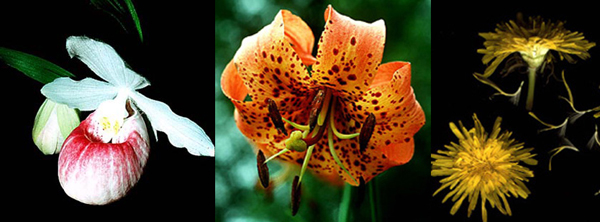Vascular
Flora of Wisconsin
- Botany 401
Spring 2020

Exams [exam 2 link][take home portion for exam 1] - take home exam due by lecture, Thursday March 5 Your first exam is coming! Monday and Tuesday, March 2/3, lab exams will be conducted during regular lab period. The
exams are closed-book except for the keying exercises. This is a pretty
typical lab exam format: many stations to visit, with questions heavily
emphasizing things you can see and often touch. Most questions on the exam
will be short answer. Many will simply involve writing the correct scientific
or common name for an herbarium specimen, live plant, or flower.
Lecture material will be integrated into the exam as short answer, matching, true/false, and essay. Familial and generic characteristics introduced in lecture will only be covered if we also saw those families or genera in lab. Download lecture material to study. Each of the three exams (including this one) is worth 90 of the total 400 points towards your final grade in this course. Fair game for the exam: 1. All species, genera, common names, and families
listed on the handouts, including the ones you keyed out - see below for
'Master List' You should be able to identify
any plant we show you and also identify the characteristics that set it
apart. Recall that scientific names and genera are underlined (or italicized
if typed); and family names are capitalized but not underlined.
2. Gross (that is "general" !) characteristics of families and genera. This includes lecture materials and lab materials. It also includes family characteristics that you would come across in the keys. 3. Floral and vegetative features. Be able to identify them on plants. You should, for instance, be able to answer a "What is this structure?" question as well as a "Which one of these flowers has a hypanthium?" question. Be familiar with all terms presented on the floral morphology handout as well as terms that have showed up in the keys. You should be familiar with those vegetative morphology terms that pertain to the plants we have looked at in lab. You should be familiar with floral formulas; both creating them and interpreting them. 4. Keying. Be able to key out any plant you see using Field Manual of Michigan Flora or the conifer / vascular cryptogam keys handed out. Please bring your copy of Field Manual of Michigan Flora to the exam as you will probably need it to key out a plant. 5. Lecture material. Ideas and concepts raised in lecture pertaining to the flora, vegetation of Wisconsin.These could involve biogeographical patterns, unusual phylogenetic relationships, nomenclatural issues, breeding systems, pollination biology, ecological adaptations, endangered species, invasive species. Download lecture material to study. Master list of plants to know You are responsible for all families, genera, species, and common names listed below. You are responsible to know information about the 8 highlighted families from the labs (in red below). You should know some major groupings above the family level: the phyla covered and informal gropus (e.g. "basal angiosperms," "basal eudicots," "rosids," "caryophyllids"). You are not responsible for knowing orders. |
Vascular cryptogams
Lycopodiophyta
Huperzia lucidulum (Lycopodiaceae) 'Shining clubmoss'
Dendrolycopodium (Lycopodiaceae) 'Tree clubmoss', 'Ground-pine'Polypodiophyta
Adiantum pedatum (Pteridaceae) 'Maidenhair fern'
Dryopteris (Dryopteridaceae) 'Wood or Shield fern'
Equisetum (Equisetaceae) 'Horsetail'
Polypodium virginianum (Polypodiaceae) 'Rock-cap fern'
Athyrium (Athyriaceae) 'Lady fern'
Pteridium aquilinum (Dennstaedtiaceae) 'Bracken fern'
Onoclea sensibilis (Onocleaceae) 'Sensitive fern'
Osmunda (Osmundaceae) 'Cinnamon or Interrupted fern'Gymnosperms
Cupressaceae
Juniperus (Cupressaceae) 'Juniper'
Thuja occidentalis (Cupressaceae) 'Northern white cedar,' 'Eastern arborvitae'Pinaceae
Abies balsamea (Pinaceae) 'Balsam fir'
Larix (Pinaceae) 'Tamarack,' 'Larch'
Picea (Pinaceae) 'Spruce'
Pinus banksiana (Pinaceae) 'Jack pine'
Pinus strobus (Pinaceae) 'White pine'
Pinus resinosa (Pinaceae) 'Red pine'
Tsuga canadensis (Pinaceae) 'Eastern hemlock'Taxaceae
Taxus (Taxaceae) 'Yew'
Basal angiosperms
Aristolochiaceae
Asarum canadense (Aristolochiaceae) 'Wild ginger'
Ceratophyllaceae
Ceratophyllum demersum (Ceratophyllaceae) 'Coon's tail'
Magnoliaceae
Magnolia (Magnoliaceae) 'Magnolia'
Nymphaeaceae
Nuphar variegatum (Nymphaeaceae) 'Yellow pond lily,' 'Spatterdock'
Nymphaea (Nymphaeceae) 'White water-lily'Basal eudicots
Berberidaceae
Caulophyllum thalictroides (Berberidaceae) 'Blue Cohosh'
Berberis (Berberidaceae) 'Barberry'
Podophyllum peltatum (Berberidaceae) 'May-apple,' 'Mandrake'Menispermaceae
Menispermum (Menispermaceae) 'Moonseed'
Papaveraceae
Chelidonium (Papaveraceae) 'Celandine'
Sanguinaria canadensis (Papaveraceae) 'Bloodroot'
Dicentra (Papaveraceae) 'Dutchman's-breeches'Ranunculaceae
Actaea rubra (Ranunculaceae) 'Red baneberry'
Anemone (formerly Hepatica) (Ranunculaceae) 'Hepatica,' 'Liver leaf'
Anemone quinquefolia (Ranunculaceae) 'Wood anemone'
Aquilegia canadensis (Ranunculaceae) 'Columbine'
Caltha palustris (Ranunculaceae) 'Marsh marigold'
Enemion (Ranunculaceae) 'False rue anemone'
Ranunculus hispidus (Ranunculaceae) 'Swamp buttercup'
Thalictrum dioicum (Ranunculaceae) 'Early meadow-rue'Caryophyllids
Amaranthaceae
Amaranthus (Amaranthaceae) 'Amaranth'
Chenopodium album (Amaranthaceae) 'Lamb's quarters'Cactaceae
Opuntia (Cactaceae) 'Prickly-pear'
Caryophyllaceae
Cerastium fontanum (Caryophyllaceae) 'Mouse-ear chickweed'
Silene latifolia (Caryophyllaceae) 'White campion' 'Bladder campion'Droseraceae
Drosera rotundifolia (Droseraceae) 'Round-leaved sundew'
Montiaceae (formerly Portulacaceae)
Claytonia virginica (Montiaceae) 'Spring beauty'
Phytolaccaceae
Phytolacca (Phytolaccaceae) 'Pokeweed'
Polygonaceae
Persicaria (Polygonaceae) 'Smartweed'
Rumex acetosella (Polygonaceae) 'Sour dock'Rosids
Cannabaceae
Cannabis (Cannabaceae) 'Hemp' plus many other common names
Crassulaceae
Sedum (Crassulaceae) 'Stonecrop'
Cucurbitaceae
Echinocystis lobata (Cucurbitaceae) 'Wild cucumber'
Euphorbiaceae
Euphorbia (Euphorbiaceae) 'Spurge'
Fabaceae
Lupinus perennis (Fabaceae) 'Wild lupine'
Robinia pseudoacacia (Fabaceae) 'Black locust'
Trifolium (Fabaceae) 'Clover'Grossulariaceae
Ribes americanum (Grossulariaceae) 'Eastern Black Currant'
Hamamelidaceae
Hamamelis virginiana (Hamamelidaceae) 'American witch-hazel'
Hypericaceae
Hypericum perforatum (Hypericaceae) 'Common St. John's-wort'
Moraceae
Morus alba (Moraceae) 'White mulberry'
Rhamnaceae
Ceanothus americanus (Rhamnaceae) 'New Jersey Tea'
Rhamnus (Rhamnaceae) 'Buckthorn'Rosaceae
Agrimonia gryposepala (Rosaceae) 'Common agrimony'
Geum (Rosaceae) 'Avens'
Potentilla (Rosaceae) 'Cinquefoil,' 'Potentilla'
Prunus serotina (Rosaceae) 'Wild black cherry'
Rosa multiflora (Rosaceae) 'Multiflora rose'
Rubus (Rosaceae) 'Bramble,' 'Raspberry,' 'Blackberry'
Spiraea tomentosa (Rosaceae) 'Hardhack,' 'Steeple bush'Salicaceae
Populus (Salicaceae) 'Aspen,' 'Cottonwood,' 'Poplar'
Salix (Salicaceae) 'Willow'Saxifragaceae
Heuchera richardsonii (Saxifragaceae) 'Prairie alumroot'
Mitella (Saxifragaceae) 'Bishop's-cap,' 'Miterwort'Ulmaceae
Ulmus americana (Ulmaceae) 'American elm'
Urticaceae
Urtica (Urticaceae) 'Nettle'
Violaceae
Viola pubescens (Violaceae) 'Yellow violet'
Viola sororia (Violaceae) 'Common blue violet'Vitaceae
Parthenocissus (Vitaceae) 'Virginia creeper'
Vitis (Vitaceae) 'wild grape'
2nd Exam - not cumulative, only 2nd half of labs/lectures[take home portion for exam 2] - take home exam due on or before Tuesday April 22 Your second exam is coming. Wednesday and Thursday, April 15 and 16, lab exams will be conducted during regular lab period. The exams are closed-book except for the keying exercises. The format will be similar to the last exam. Most questions on the exam will be short answer. Many will simply involve writing the correct scientific name (underlined binomial), family and common name for an herbarium specimen, live plant, or flower. Lecture material will be integrated into the lab exam. Familial and generic characteristics introduced in lecture will only be covered if we also saw those families or genera in lab. Available here is a pdf of Lecture 2 lecture material to study - lecture questions will come from this subset. Each lab exam (including this one) is worth 90 of the total 400 points towards your final grade in this course. Fair game for the exam: 1. All species, genera, common names, and families listed on the handouts, including the ones you keyed out - see below for 'Master List'. You should be able to identify any plant we show you and also identify the characteristics that set it apart. Recall that scientific names and genera are underlined (or italicized if typed); and family names are capitalized but not underlined. 2. Gross characteristics of families and genera. This includes lecture materials and lab materials. It also includes family characteristics that you would come across in the keys. 3. Floral and vegetative features. Know the vocabulary terms that have been in the lab handouts and that are used in the keys. 4. Keying. Be proficient in the use of keys. 5. Lecture material. Ideas and concepts raised in lecture pertaining to the flora, vegetation of Wisconsin. These could involve biogeographical patterns, unusual phylogenetic relationships, nomenclatural issues, breeding systems, pollination biology, ecological adaptations, endangered species, invasive species. Only the first of two special lectures - Weeds (not DNA Barcoding) - will also be involved. Good luck! Please let us know if you have any questions. You are responsible for all families, genera, species, and common names listed below. You are responsible to know information from only 12 of the 21 red highlighted families from each lab - these are preceeded by asterisks. The list of 12 required families from the 21 in red are also given to you on page 2 of the pdf of Lecture 2 lecture material to study. You are not responsible for knowing orders, phyla, or superordinal angiosperm classification (e.g. "rosids," "asterids,"). |
Rosids
Juglandaceae
Carya 'Hickory'
*Fagaceae
Quercus rubra 'Red oak'
Betulaceae
Betula papyrifera 'Paper birch'
Ostrya virginiana 'Eastern hophornbeam' 'ironwood'Onagraceae
Oenothera biennis 'Common evening primrose'
Epilobium 'Willow-herb'Lythraceae
Lythrum 'Loosestrife'
Geraniaceae
Geranium maculatum 'Wild geranium'
Oxalidaceae
Oxalis 'Wood-sorrel'
Staphyleaceae
Staphylea 'Bladder- nut'
*Brassicaceae
Hesperis matronalis 'Dame's rocket'
Alliaria 'Garlic mustard'
Lepidium 'Pepper-weed, Pepper-grass'Malvaceae (including former Tiliaceae)
Malva 'Mallow'
Tilia americana (former Tiliaceae) 'Basswood'Anacardiaceae
Rhus glabra 'Smooth sumac'
Toxicodendron radicans 'Poison ivy'Rutaceae
Zanthoxylum 'Prickly-ash'
Sapindaceae
Acer negundo 'Box-elder,' 'Ash-leaved maple'
Acer saccharum 'Sugar maple'
Asterids
*Ericaceae
Vaccinium angustifolium 'Low sweet blueberry'
Gaylussacia baccata 'Huckleberry'
Monotropa 'Indian pipe,' 'Pinesap'
Pyrola 'Shin-leaf,' 'Wintergreen'Primulaceae
Primula meadia 'Shooting star'
Sarraceniaceae
Sarracenia purpurea 'Pitcher plant'
Polemoniaceae
Polemonium reptans 'Jacob's ladder'
Phlox 'Phlox'Balsaminaceae
Impatiens 'Touch-me-not,' 'Jewelweed'
Cornaceae
Cornus racemosa 'Gray dogwood'
Gentianaceae
Gentiana andrewsii 'Bottle gentian'
*Apocynaceae
Apocynum androsaemifolium 'Spreading dogbane'
Asclepias syriaca 'Common milkweed'Rubiaceae
Galium aparine 'Cleavers'
Solanaceae
Solanum 'nightshade,' 'horse-nettle'
Convolvulaceae
Convolvulus arvensis 'Field bindweed,' 'Hedge bindweed'
Cuscuta 'Dodder'Boraginaceae
Lithospermum 'Pucoon,' 'gromwell'
Hydrophyllum virginianum 'Waterleaf'
Mertensia 'Bluebells'Oleaceae
Fraxinus pennsylvanica 'Green ash,' 'Red ash'
*Lamiaceae
Nepeta cataria 'Catnip'
Monarda fistulosa 'Wild bergamot'
Prunella vulgaris 'Self-heal'Verbenaceae
Verbena 'Vervain'
Orobanchaceae
Pedicularis canadensis 'Lousewort,' 'Betony'
Castilleja coccinea 'Indian paint-brush'
Conopholis 'Cancer-root'Plantaginaceae
Plantago 'Plantain'
Lentibulariaceae
Utricularia 'Bladderwort'
*Adoxaceae
Viburnum lentago 'nannyberry'
Sambucus canadensis 'Elderberry,' 'American elder'Caprifoliaceae
Diervilla 'Bush-honeysuckle'
Linnaea 'Twinflower'
Lonicera x bella 'hybrid Honeysuckle'*Apiaceae (=Umbeliferae)
Daucus carota 'Queen Anne's lace,' 'Wild carrot'
Osmorhiza claytonii 'Hairy sweet cicely'
Sanicula 'Black snakeroot'Araliaceae
Aralia nudicaulis 'Wild sarsaparilla'
Panax quinquefolius 'American ginsengCampanulaceae
Campanula rapunculoides 'Creeping bellflower,' 'European bellflower'
Lobelia siphilitica 'Great blue lobelia'*Asteraceae (=Compositae)
Achillea millefolium 'Common yarrow.'
Coreopsis palmata 'Prairie tickseed,' 'Prairie coreopsis.'
Aster novae-angliae 'New England aster'
Packera paupercula 'Balsam ragwort'
Hieracium aurantiacum 'Hairy hawkweed'
Antennaria 'Pussy-toes'
Helianthus 'Sunflower'
Solidago 'Goldenrod'Monocots
Alismataceae
Sagittaria 'Arrow head'
*Araceae
Arisaema triphyllum 'Jack-in-the-pulpit'
Symplocarpus foetidus 'Skunk cabbage'*Liliaceae
Erythronium albidum 'White trout lily'
Melanthiaceae
Trillium grandiflorum 'Big white trillium,' 'Large-flowered trillium'
Asparagaceae
Maianthemum canadense 'Canada mayflower,' 'Wild lily of the valley'
Colchicaceae
Uvularia 'Bellwort,' 'Merrybell'
Iridaceae
Iris 'Blue flag' 'Iris'
Sisyrinchium 'Blue-eyed grass.'Orchidaceae
Goodyera 'Rattlesnake plantain'
Dioscoreaceae
Dioscorea villosa 'Wild yam,' 'Colic-root'
Smilacaceae
Smilax 'Carrion flower,' 'Greenbriar'
Commelinaceae
Tradescantia ohiensis 'Common spiderwort'
Typhaceae
Typha 'Cat-tail'
*Poaceae (=Gramineae)
Dichanthelium 'Panic grass'
Dactylis 'Orchard grass'
Phalaris arundinacea 'Reed canary grass'*Cyperaceae
Carex pensylvanica 'Common oak sedge' 'Pennsylvania sedge'
Schoenoplectus tabernaemontani 'Soft-stem bullrush'Juncaceae
Juncus 'Path rush'

